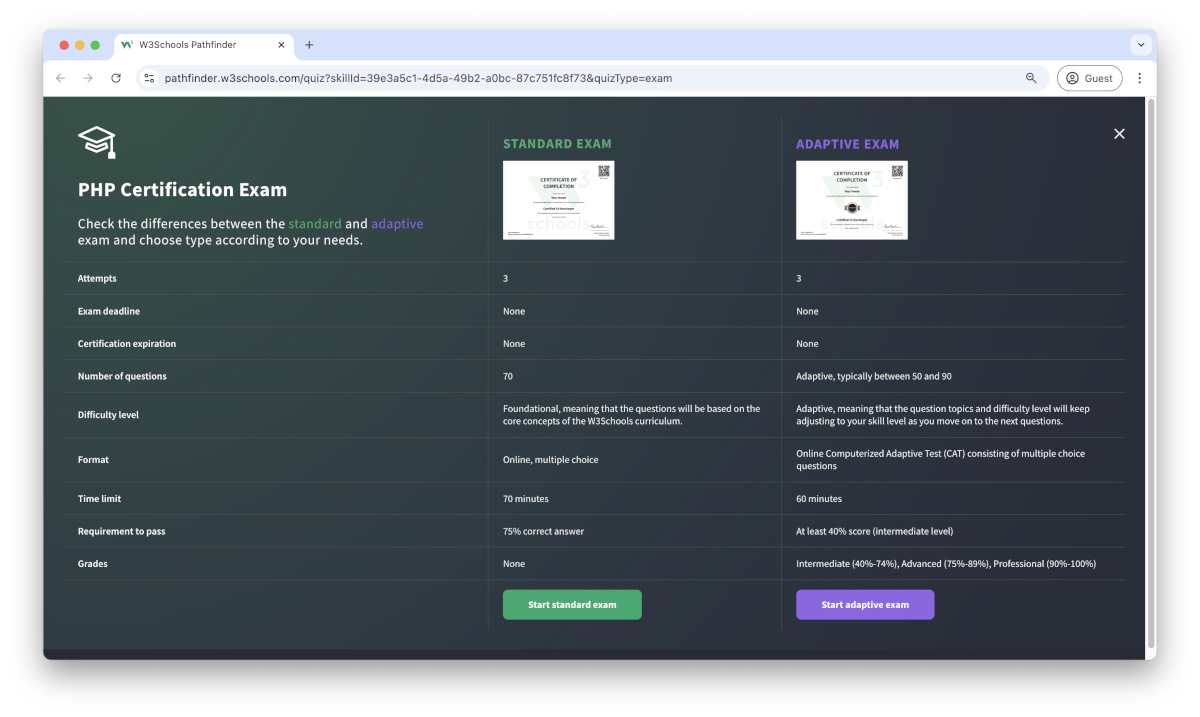PHP Syllabus
Introduction
The W3Schools PHP Tutorial is comprehensive and beginner-friendly.
It will give you a fundamental knowledge of PHP.
It is designed for beginners and requires no prior experience with programming.
The content has been carefully made to be bite-sized, simple, and easy to understand.
The content has been proven by millions of users over the years. It is updated and improved frequently.
The syllabus outline and its sequence are structured so you can learn PHP step by step, from the introduction to creating your first application with PHP.
Learning Outcomes
- Understand what PHP is and how to write PHP scripts.
- Learn PHP syntax and how to use variables and data types.
- Use conditional statements (if, else, switch) and loops (while, for).
- Use functions to make code reusable.
- Handle forms and user input with PHP.
- Learn how to use Arrays and file management.
- Use PHP to connect to a database and to store and retrieve data.
- Understand error handling and keep information safe.
- Type and run PHP programs.
Note: Are you a teacher teaching PHP? W3Schools Academy is a toolbox of features that can help you teach. It offers classroom features such as pre-built study plans, classroom administration and much more. Read more about Academy here.
Which Subjects Are PHP Relevant For?
-
Websites:
PHP is a popular backend scripting language used for creating interactive websites. -
Computer Science:
PHP can be used to teach backend programming and web development. -
Information Technology (IT):
PHP teaches students how to make and maintain websites and web apps. -
Web Development:
PHP can be used for understanding how to create and handle interactive web pages and link them to databases. -
Business Studies/ Entrepreneurship:
PHP can be useful for small businesses for simple tasks on websites such as for creating forms and managing data. -
Media and Communications:
PHP can be used to create and run media sites and content management systems (CMS). -
Mathematics:
PHP can be used to make web-based calculators and apps that solve math problems. -
Economics:
PHP can be used to make tools for economic modeling, data analysis, and polls.
Activities
In this tutorial we offer different activities for you to learn PHP for free:
Sign in to Track Progress
You can also create a free account to track your progress.
As a signed-in user, you get access to features such as:
- Learning paths
- Sandbox and lab environments
- Achievements
- And much more!
Overview of the Modules
- PHP Introduction
- PHP Install
- PHP Syntax
- PHP Comments
- PHP Variables
- PHP Echo / Print
- PHP Data Types
- PHP Strings
- PHP Numbers
- PHP Casting
- PHP Math
- PHP Constants
- PHP Magic Constants
- PHP Operators
- PHP If...Else
- PHP Switch
- PHP Loops
- PHP Functions
- PHP Arrays
- PHP Superglobals
- PHP Regular Expressions
- PHP Forms Handling
- PHP Form Validation
- PHP Form Required
- PHP Form URL/E-mail
- PHP Form Complete
- PHP Date and Time
- PHP Include Files
- PHP File Handling
- PHP Open/Read
- PHP Create/Write
- PHP Create/Write
- PHP File Upload
- PHP Cookies
- PHP Sessions
- PHP Filters
- PHP Filters Advanced
- PHP Callback Functions
- PHP JSON
- PHP Exceptions
- PHP What is OOP
- PHP Classes/Objects
- PHP Constructor
- PHP Destructor
- PHP Access Modifiers
- PHP Inheritance
- PHP Constants
- PHP Abstract Classes
- PHP Interfaces
- PHP Traits
- PHP Static Methods
- PHP Static Properties
- PHP Namespaces
- PHP Iterables
- PHP MySQL Database
- PHP XML
- PHP AJAX
- PHP MySQL Database
- PHP Error Handling
- PHP Security
Sandbox and Lab Environment
PHP, like any other coding language, is best learned by working hands-on with code.
Easily try code with our "Try it Yourself" editor.
Here, you can edit PHP code and view the result.
ExampleGet your own PHP Server
<!DOCTYPE html>
<html>
<body>
<?php
echo "My first PHP script!";
?>
</body>
</html>
If you want to explore more and host your project, we have a feature called Spaces that allows you to build, test and deploy PHP code and other backend languages.
Here you get a secure sandbox environment called Spaces, where you can practice coding and test projects in real-time.
Spaces allow you to test, build, and deploy code. This includes a W3Schools subdomain, hosting, and secure SSL certificates.
Spaces require no installation and run directly in the browser.
Features include:
- Collaboration
- File navigator
- Terminal & log
- Package manager
- Database
- Environment manager
- Analytics

PHP Certification
W3Schools offers an end-of-pathway certification program.
Here you can take exams to get certified.
The PHP exam is a test that summarizes the W3Schools PHP syllabus.
After passing the exam you get the "Certified PHP Developer" Certification.
There are two different types of certifications:
- Non-adaptive
- Adaptive
The non-adaptive is pass or no pass.
The adaptive certification is adaptive and graded; students will get a grade from intermediate, advanced to professional.

Are You a Teacher?
Are you interested in learning how you can use W3Schools Academy to Teach PHP programming?
Watch a demo of W3Schools Academy. You'll see how it works, and discover how it can make teaching programming easier and more engaging.


